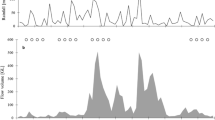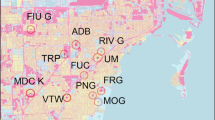Abstract
We investigated the use of aquatic and terrestrial floodplain habitats by lentic and lotic turtles inhabiting the Missouri River, a contemporary, regulated large river. Specifically, we tested whether habitats were used differentially by turtle species, sexes, and life stages over biologically determined spatial and temporal scales. We monitored female and male false map turtles (Graptemys pseudogeographica) and slider turtles (Trachemys scripta) for 14 months, using radiotelemetry. In addition, over a 3-year period we trapped G. pseudogeographica (n=591) and T. scripta (n=129) to supplement data on habitat use. Movements based on radiotelemetry and recaptures were summarized for each individual. Both species of turtles displayed dynamic annual activity patterns and used diverse habitats including those typically considered terrestrial. Although G. pseudogeographica and T. scripta spent a substantial portion of the year in the Missouri River (primarily in the cool months), newly created scour habitats also appeared to attract turtles during the cool season. However, in the warm months, habitat use became much more diverse, with turtles occupying all identified habitats including flooded agriculture and forest. Relative to their proportions, slough and scour habitats appeared to be highly favored while forests older than 4 years and agricultural habitats were proportionally less favored. We found few differences between species. However, males of both species were consistently more sedentary, used half as many habitats, and moved half as far from the river as did females, especially during May through July. Juveniles of both species were captured on average farther from the river than were adults, perhaps reflecting the close proximity of both nesting areas and shallow, productive habitats free of aquatic predators. We estimate a riparian zone of 449 m that encompasses 95% of the population movements away from the river and discuss the quality of habitats important to reproduction and survival of lentic and lotic floodplain turtles. These spatial and temporal movement patterns, in light of their potential adaptive costs and benefits to G. pseudogeographica and T. scripta, are critical to understanding the ecology of long-lived vertebrates that depend on contemporary large rivers.
Similar content being viewed by others
Author information
Authors and Affiliations
Additional information
Received: 26 January 1999 / Accepted: 15 July 1999
Rights and permissions
About this article
Cite this article
Bodie, J., Semlitsch, R. Spatial and temporal use of floodplain habitats by lentic and lotic species of aquatic turtles. Oecologia 122, 138–146 (2000). https://doi.org/10.1007/PL00008830
Issue Date:
DOI: https://doi.org/10.1007/PL00008830




